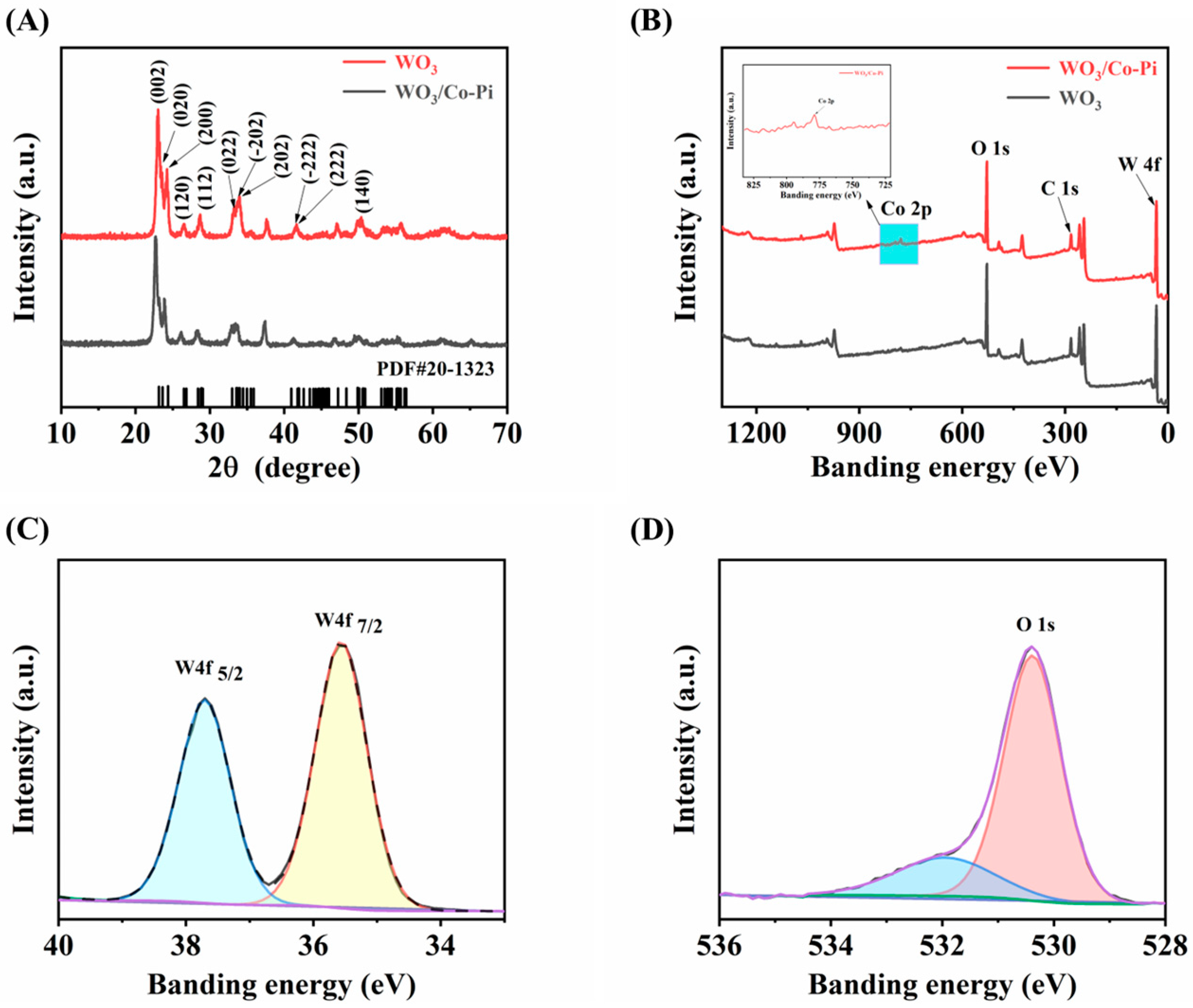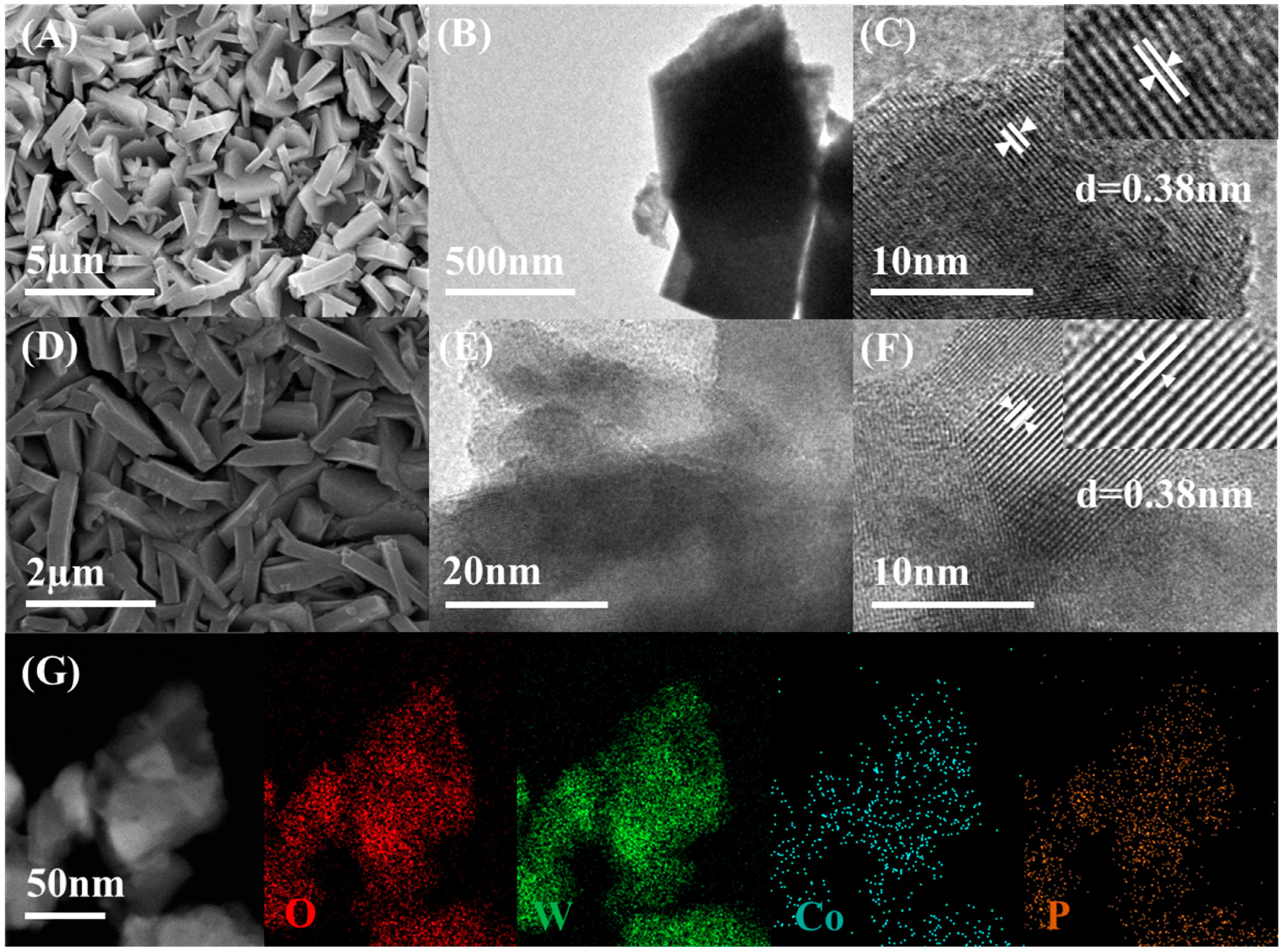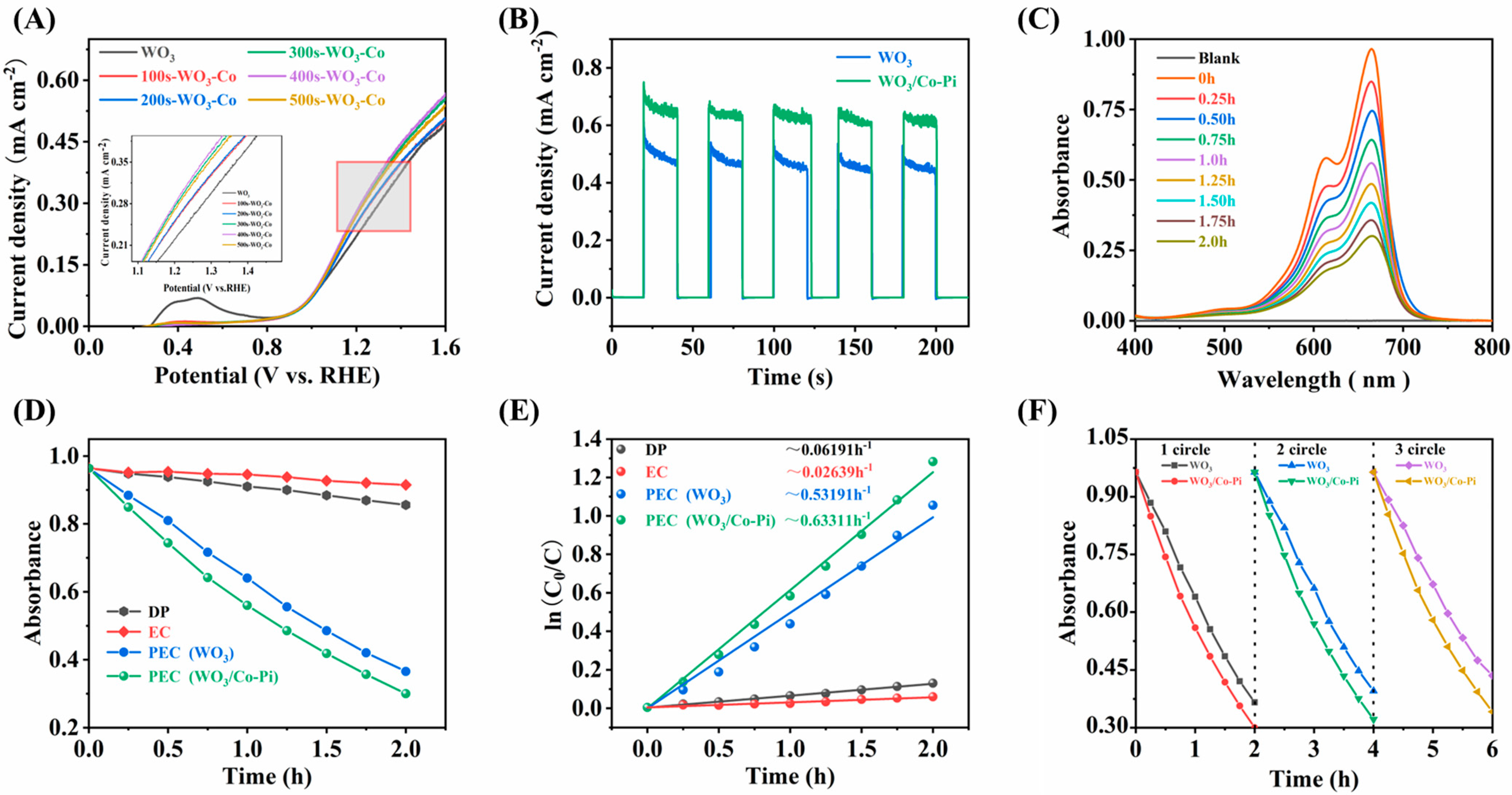Cobalt-Phosphate (Co-Pi)-Modified WO3 Photoanodes for Performance-Enhanced Photoelectrochemical Wastewater Degradation
Abstract
:1. Introduction
2. Experimental Section
2.1. Materials
2.2. Preparation of WO3 Films
2.3. Preparation of CO-Pi/WO3 Films
2.4. Characterization of Thin Films
3. Results and Discussion
4. Conclusions
Supplementary Materials
Author Contributions
Funding
Conflicts of Interest
References
- Zhang, F.; Zhao, P.; Niu, M.; Maddy, J. The survey of key technologies in hydrogen energy storage. Int. J. Hydrog. Energy 2016, 41, 14535–14552. [Google Scholar] [CrossRef]
- Schultz, D.; Yoon, T. Solar Synthesis: Prospects in Visible Light Photocatalysis. Science 2014, 343, 985. [Google Scholar] [CrossRef] [PubMed] [Green Version]
- Hisatomi, T.; Domen, K. Reaction systems for solar hydrogen production via water splitting with particulate semiconductor photocatalysts. Nat. Catal. 2019, 2, 387–399. [Google Scholar] [CrossRef]
- Awfa, D.; Ateia, M.; Fujii, M.; Yoshimura, C. Photocatalytic degradation of organic micropollutants: Inhibition mechanisms by different fractions of natural organic matter. Water Res. 2020, 174, 11. [Google Scholar] [CrossRef]
- Lin, Z.; Li, J.; Shen, W.; Corriou, J.; Chen, X.; Xi, H. Different photocatalytic levels of organics in papermaking wastewater by flocculation-photocatalysis and SBR-photocatalysis: Degradation and GC? MS experiments, adsorption and photocatalysis simulations. Chem. Eng. J. 2021, 412, 14. [Google Scholar] [CrossRef]
- Rueda-Marquez, J.; Levchuk, I.; Ibanez, P.; Sillanpaa, M. A critical review on application of photocatalysis for toxicity reduction of real wastewaters. J. Clean. Prod. 2020, 258, 13. [Google Scholar] [CrossRef]
- Zhao, Y.; Wang, Y.; Chi, H.; Zhang, Y.; Sun, C.; Wei, H.; Li, R. Coupling photocatalytic water oxidation on decahedron BiVO4 crystals with catalytic wet peroxide oxidation for removing organic pollutions in wastewater. Appl. Catal. B Environ. 2022, 318, 9. [Google Scholar] [CrossRef]
- Garcia-Segura, S.; Brillas, E. Applied photoelectrocatalysis on the degradation of organic pollutants in wastewaters. J. Photochem. Photobiol. C Photochem. Rev. 2017, 31, 1–35. [Google Scholar] [CrossRef]
- Sreedhar, N.; Kumar, M.; Al Jitan, S.; Thomas, N.; Palmisano, G.; Arafat, H. 3D printed photocatalytic feed spacers functionalized with beta-FeOOH nanorods inducing pollutant degradation and membrane cleaning capabilities in water treatment. Appl. Catal. B Environ. 2022, 300, 120318. [Google Scholar] [CrossRef]
- Al-Nuaim, M.; Alwasiti, A.; Shnain, Z. The photocatalytic process in the treatment of polluted water. Chem. Pap. 2022. [Google Scholar] [CrossRef]
- Xu, P.; McCool, N.; Mallouk, T. Water splitting dye-sensitized solar cells. Nano Today 2017, 14, 42–58. [Google Scholar] [CrossRef]
- Henderson, M. A surface science perspective on TiO2 photocatalysis. Surf. Sci. Rep. 2011, 66, 185–297. [Google Scholar]
- Jia, J.; Seitz, L.; Benck, J.; Huo, Y.; Chen, Y.; Ng, J.; Bilir, T.; Harris, J.; Jaramillo, T. Solar water splitting by photovoltaic-electrolysis with a solar-to-hydrogen efficiency over 30%. Nat. Commun. 2016, 7, 6. [Google Scholar] [CrossRef] [PubMed] [Green Version]
- Jiang, C.; Moniz, S.; Wang, A.; Zhang, T.; Tang, J. Photoelectrochemical devices for solar water splitting—Materials and challenges. Chem. Soc. Rev. 2017, 46, 4645–4660. [Google Scholar] [CrossRef] [PubMed] [Green Version]
- Guo, Q.; Zhou, C.; Ma, Z.; Yang, X. Fundamentals of TiO2 Photocatalysis: Concepts, Mechanisms, and Challenges. Adv. Mater. 2019, 31, 26. [Google Scholar] [CrossRef]
- Zhang, K.; Ma, M.; Li, P.; Wang, D.; Park, J. Water Splitting Progress in Tandem Devices: Moving Photolysis beyond Electrolysis. Adv. Energy Mater. 2016, 6, 16. [Google Scholar] [CrossRef]
- Jacobsson, T.; Fjällström, V.; Edoff, M.; Edvinsson, T. Sustainable solar hydrogen production: From photoelectrochemical cells to PV-electrolyzers and back again. Energy Environ. Sci. 2014, 7, 2056–2070. [Google Scholar] [CrossRef]
- Balberg, I. Energy conversion by photoelectrochemical cells: Principles and applications. Vacuum 1983, 33, 579–583. [Google Scholar] [CrossRef]
- Fujishima, A.; Honda, K. Electrochemical Photolysis of Water at a Semiconductor Electrode. Nature 1972, 238, 37–38. [Google Scholar] [CrossRef]
- Su, J.; Feng, X.; Sloppy, J.; Guo, L.; Grimes, C. Vertically Aligned WO3 Nanowire Arrays Grown Directly on Transparent Conducting Oxide Coated Glass: Synthesis and Photoelectrochemical Properties. Nano Lett. 2010, 11, 203–208. [Google Scholar] [CrossRef]
- Olejnicek, J.; Brunclikova, M.; Kment, S.; Hubicka, Z.; Kmentova, H.; Ksirova, P.; Cada, M.; Zlamal, M.; Krysa, J. WO3 thin films prepared by sedimentation and plasma sputtering. Chem. Eng. J. 2017, 318, 281–288. [Google Scholar] [CrossRef]
- Shin, S.; Han, H.; Kim, J.; Park, I.; Lee, M.; Hong, K.; Cho, I. A tree-like nanoporous WO3 photoanode with enhanced charge transport efficiency for photoelectrochemical water oxidation. J. Mater. Chem. A 2015, 3, 12920–12926. [Google Scholar] [CrossRef]
- Kim, W.; Tachikawa, T.; Monllor-Satoca, D.; Kim, H.; Majima, T.; Choi, W. Promoting water photooxidation on transparent WO3 thin films using an alumina overlayer. Energy Environ. Sci. 2013, 6, 3732–3739. [Google Scholar] [CrossRef]
- Choi, H.; Kim, E.; Hahn, S. Photocatalytic activity of Au-buffered WO3 thin films prepared by RF magnetron sputtering. Chem. Eng. J. 2010, 161, 285–288. [Google Scholar]
- Fernandes, E.; Gomes, J.; Martins, R.C. Semiconductors Application Forms and Doping Benefits to Wastewater Treatment: A Comparison of TiO2, WO3, and g-C3N4. Catalysts 2022, 12, 1218. [Google Scholar] [CrossRef]
- Zhong, D.; Cornuz, M.; Sivula, K.; Grätzel, M.; Gamelin, D.R. Photo-assisted electrodeposition of cobalt–phosphate (Co–Pi) catalyst on hematite photoanodes for solar water oxidation. Energy Environ. Sci. 2011, 4, 1759–1764. [Google Scholar] [CrossRef]
- Gamelin, D.R. Water splitting: Catalyst or spectator? Nat. Chem. 2012, 4, 965–967. [Google Scholar]
- Carroll, G.; Gamelin, D.R. Kinetic analysis of photoelectrochemical water oxidation by mesostructured Co-Pi/α-Fe2O3 photoanodes. J. Mater. Chem. A 2015, 4, 2986–2994. [Google Scholar] [CrossRef]
- Seabold, J.; Choi, K.-S. Effect of a Cobalt-Based Oxygen Evolution Catalyst on the Stability and the Selectivity of Photo-Oxidation Reactions of a WO3 Photoanode. Chem. Mater. 2011, 23, 1105–1112. [Google Scholar] [CrossRef]
- Ostachavičiūtė, S.; Šulčiūtė, A.; Valatka, E. The morphology and electrochemical properties of WO3 and Se-WO3 films modified with cobalt-based oxygen evolution catalyst. Mater. Sci. Eng. B 2020, 260, 114630. [Google Scholar] [CrossRef]
- Surendranath, Y.; Kanan, M.; Nocera, D.G. Mechanistic Studies of the Oxygen Evolution Reaction by a Cobalt-Phosphate Catalyst at Neutral pH. J. Am. Chem. Soc. 2010, 132, 16501–16509. [Google Scholar] [CrossRef]
- Steinmiller, E.; Choi, K.-S. Photochemical deposition of cobalt-based oxygen evolving catalyst on a semiconductor photoanode for solar oxygen production. Proc. Natl. Acad. Sci. USA 2009, 106, 20633–20636. [Google Scholar] [CrossRef] [Green Version]
- Brodsky, C.; Bediako, D.; Shi, C.; Keane, T.; Costentin, C.; Billinge, S.; Nocera, D.G. Proton–Electron Conductivity in Thin Films of a Cobalt–Oxygen Evolving Catalyst. ACS Appl. Energy Mater. 2019, 2, 3–12. [Google Scholar] [CrossRef]
- Tsuneda, T.; Ten-no, S. Water–oxidation mechanism of cobalt phosphate co-catalyst in artificial photosynthesis: A theoretical study. Phys. Chem. Chem. Phys. 2022, 24, 4674–4682. [Google Scholar] [CrossRef] [PubMed]
- Kanan, M.; Nocera, D. In Situ Formation of an Oxygen-Evolving Catalyst in Neutral Water Containing Phosphate and Co2+. Science 2008, 321, 1072–1075. [Google Scholar]
- Li, X.; Wan, J.; Ma, Y.; Wang, Y.; Li, X. Study on cobalt-phosphate (Co-Pi) modified BiVO4/Cu2O photoanode to significantly inhibit photochemical corrosion and improve the photoelectrochemical performance. Chem. Eng. J. 2021, 404, 127054. [Google Scholar]
- Cai, Q.; Liu, Z.; Li, J.; Han, C.; Tong, Z. Ga-Doped AgInS2 Modified with Co–Pi Co–catalyst for Efficient Photoelectrochemical Water Splitting. Catal. Lett. 2020, 150, 1089–1097. [Google Scholar]
- Zeng, Q.; Li, J.; Bai, J.; Li, X.; Xia, L.; Zhou, B. Preparation of vertically aligned WO3 nanoplate array films based on peroxotungstate reduction reaction and their excellent photoelectrocatalytic performance. Appl. Catal. B: Environ. 2017, 202, 388–396. [Google Scholar] [CrossRef]
- Patrick, E.; Orazem, M.; Sanchez, J.; Nishida, T. Corrosion of tungsten microelectrodes used in neural recording applications. J. Neurosci. Methods 2011, 198, 158–171. [Google Scholar] [CrossRef] [PubMed] [Green Version]
- Kalanur, S.; Yoo, I.-H.; Eom, K.; Seo, H. Enhancement of photoelectrochemical water splitting response of WO3 by Means of Bi doping. J. Catal. 2017, 357, 127–137. [Google Scholar] [CrossRef]
- You, Y.; Tian, W.; Min, L.; Cao, F.; Deng, K.; Li, L. TiO2/WO3 Bilayer as Electron Transport Layer for Efficient Planar Perovskite Solar Cell with Efficiency Exceeding 20%. Adv. Mater. Interfaces 2019. [Google Scholar] [CrossRef]
- Zhan, F.; Li, J.; Li, W.; Yang, Y.; Liu, W.; Li, Y. In situ synthesis of CdS/CdWO4/WO3 heterojunction films with enhanced photoelectrochemical properties. J. Power Sources 2016, 325, 591–597. [Google Scholar] [CrossRef]
- Ramachandran, R.; Dendooven, J.; Detavernier, C. Plasma enhanced atomic layer deposition of Fe2O3 thin films. J. Mater. Chem. A 2014, 2, 10662–10667. [Google Scholar] [CrossRef]
- Ge, R.; Li, L.; Su, J.; Lin, Y.; Tian, Z.; Chen, L. Ultrafine Defective RuO2 Electrocatayst Integrated on Carbon Cloth for Robust Water Oxidation in Acidic Media. Adv. Energy Mater. 2019, 9, 9. [Google Scholar]
- Verma, A.; Johnson, G.; Corbin, D.; Shiflett, M. Separation of Lithium and Cobalt from LiCoO2: A Unique Critical Metals Recovery Process Utilizing Oxalate Chemistry. ACS Sustain. Chem. Eng. 2020, 8, 6100–6108. [Google Scholar] [CrossRef]



Disclaimer/Publisher’s Note: The statements, opinions and data contained in all publications are solely those of the individual author(s) and contributor(s) and not of MDPI and/or the editor(s). MDPI and/or the editor(s) disclaim responsibility for any injury to people or property resulting from any ideas, methods, instructions or products referred to in the content. |
© 2023 by the authors. Licensee MDPI, Basel, Switzerland. This article is an open access article distributed under the terms and conditions of the Creative Commons Attribution (CC BY) license (https://creativecommons.org/licenses/by/4.0/).
Share and Cite
Zhang, J.; Sun, W.; Ding, X.; Xia, K.; Liu, T.; Zhang, X. Cobalt-Phosphate (Co-Pi)-Modified WO3 Photoanodes for Performance-Enhanced Photoelectrochemical Wastewater Degradation. Nanomaterials 2023, 13, 526. https://doi.org/10.3390/nano13030526
Zhang J, Sun W, Ding X, Xia K, Liu T, Zhang X. Cobalt-Phosphate (Co-Pi)-Modified WO3 Photoanodes for Performance-Enhanced Photoelectrochemical Wastewater Degradation. Nanomaterials. 2023; 13(3):526. https://doi.org/10.3390/nano13030526
Chicago/Turabian StyleZhang, Jiakun, Weixu Sun, Xin Ding, Kai Xia, Tao Liu, and Xiaodong Zhang. 2023. "Cobalt-Phosphate (Co-Pi)-Modified WO3 Photoanodes for Performance-Enhanced Photoelectrochemical Wastewater Degradation" Nanomaterials 13, no. 3: 526. https://doi.org/10.3390/nano13030526



